College interns help bridge language gap between clinicians and patients
When two people speak different languages, the communication barrier becomes even higher in a medical situation. Thanks to the services of the CC Social Work Department’s Language Interpreters Program, that obstacle is less of a concern for CC patients. And not only does the program provide a benefit for patients, but it also serves as an advantage for college students who are fortunate enough to be selected as interns in the program.
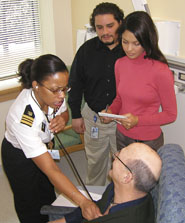 |
Lt. Cmdr. Stacy Barley, a clinical nurse, conducts an examination with the help of CC interpreter José Rosado-Santiago and Alma Luisa Andrade, the CC Language Interpreters Program’s college intern for spring 2006.
|
Each year since the student interpreters program began in 2000, the CC chooses one intern from a pool of college students across the country for the coveted spot as a CC interpreter. Sponsored by the Hispanic Association of Colleges and Universities (HACU), based in San Antonio, Texas, the National Internship Program provides one student each semester (15 weeks) and one per summer break (10 weeks) the opportunity to serve CC patients.
The program’s two full-time interpreters, joined by the college intern selected for each semester, interpret in Spanish, the language spoken by approximately 80 percent of CC patients who speak languages other than English.
“I believe that to be a proficient interpreter, one must be able to understand the vast array of terms and nomenclature used in a medical setting,” says Alma Luisa Andrade, a senior from the University of Arizona and the current student interpreter for the spring 2006 term. “My biggest challenge is understanding each situation and, optimally, each patient’s disorder as well as possible treatments or procedures, risks, expected outcomes and what the doctors wish to convey to the patients as the optimal treatments.” Born in Mexico and raised in Tucson, Arizona, Andrade is fluent in both Spanish and Portuguese. She will serve as Spanish interpreter until the summer intern is selected to fill her place.
“The main role of the interpreter is to act as a conduit,” says CC interpreter José Rosado-Santiago. “That means rendering in one language exactly what has been said in the other without adding, omitting or changing anything.”
Rosado-Santiago, who is responsible for selecting, training and mentoring the interns, was one of the first students accepted to intern at the CC. As a student, he participated in the process of creating the full-time interpreter positions and later decided to remain on staff. He now interviews the student candidates from the HACU internship program to ensure they meet the rigorous requirements of the job.
“I probe their language skills, multicultural skills, adaptability to a clinical environment and background in science or health as well as their interests and academic goals,” he says. “By the time they arrive, the students have read the assigned materials on medical research, interpretation, basic science and NIH.” They then attend the new employee orientation and are expected to comply with the same guidelines as regular employees, including universal precautions, confidentiality policies and the Code of Ethics of the National Council of Interpreters in Health Care.
The ideal candidate for an internship, says Rosado-Santiago, has an academic background in languages. “Full bilingualism is essential, as well as good intercultural communication skills and the potential to become what we call a good cultural broker—someone who can master the skills to be a cultural agent of the staff and the patient.”
Upon arriving at the CC, interns spend three weeks in training before interpreting under the supervision of more seasoned interpreters. After learning from their mentor’s critiques and guidance, the interns will eventually begin interpreting on their own. “We match the degree of difficulty of the appointments with the level of skill of the student,” Rosado-Santiago says.
“Patients feel more secure with an interpreter,” says Vanessa Flores Solórzano, a former intern (2004) from Guayaquil, Ecuador, who is planning to attend medical school and pursue a Ph.D. in public policy. “During my consultations, I was able to see where my skills made a difference. Many of the patients were relaxed and better able to discuss their medical problems once they realized the communications were open and that everything was being accurately interpreted. I was able to better see the dynamics between medicine and research while at NIH and I believe every medical and health care institution should adopt a service like this.”
To learn more about the CC’s student interpreters program, contact José Rosado-Santiago at (301) 496-9549.
—By John Iler
Back to Top
Study finds potential marker to identify
sickle cell patients at high risk of complications
Researchers studying sickle cell disease have found that an enzyme, which can be measured by a simple blood test, may help determine whether a patient has a high risk of developing certain serious complications associated with the disease.
The study, led by CC and NHLBI researchers, will be published in the March 15, 2006, issue of Blood, the journal of the American Society of Hematology.
Researchers say the enzyme lactate dehydrogenase (LDH) appears to hold promise in patients with sickle cell disease as a marker for risk of pulmonary hypertension and other complications, including early death. Pulmonary hypertension—abnormally high blood pressure in the lungs—is common in sickle cell disease.
“Our findings suggest that patients with sickle cell disease and high LDH levels should have especially careful monitoring for pulmonary hypertension, a life-threatening complication,” says Dr. Gregory Kato, the lead author of the study. Kato is a clinician in the CC Department of Critical Care Medicine and director of the sickle cell vascular disease unit in the NHLBI Vascular Medicine Branch.
Sickle cell disease is a hereditary blood disorder that, in the United States, is most prevalent in blacks. An abnormal type of hemoglobin inside the red blood cells distorts their shape and interferes with blood flow.
The enzyme LDH investigated in the study is found throughout the body, especially in red blood cells, the heart, liver, lungs and muscle. A blood test measuring LDH levels is readily available and commonly used to determine tissue damage due to a variety of causes.
Researchers measured the LDH levels of 213 adults with sickle cell disease and then categorized the patients as having low, medium or high levels. The frequency of several complications of the disease was determined in the three LDH groups.
The study found that patients in the highest LDH group were more likely to experience three circulatory problems: pulmonary hypertension, leg ulcerations, and persistent and painful penile erections called priapism. Pulmonary hypertension was detected in 61 percent of patients with high LDH compared to 15 percent of patients in the lowest LDH group. Thirty-nine percent of people with high LDH reported leg ulcerations and 60 percent reported priapism at some point in time.
Mortality rates of study participants also were examined. Patients with high LDH levels had a nearly four-fold increased risk of early death compared to patients with lower LDH levels.
The study also found that high LDH levels might help to explain why pulmonary hypertension develops in sickle cell disease. High levels of LDH appear to indirectly indicate that two other proteins, hemoglobin and arginase, have broken out of red blood cells.
“Our recently published studies have suggested that when fragile red blood cells rupture and release their contents into the bloodstream, after years it may cause blood vessel walls to become diseased,” Kato says. “Our current findings further support this theory. Learning more about this chain of events will help us to identify additional potential treatments.”
Researchers from the Children’s Hospital and Research Center in Oakland, Calif., and the University of Pittsburgh School of Medicine also participated in this study.
—By Shana Potash
Back to Top
Did you wash your hands?
Did you wash your hands? That’s the question patients will pose to their caregivers as part of a safety and awareness campaign that begins this month at the Clinical Center. It’s an important question since proper hand hygiene is the easiest and most important way to prevent the spread of infections.
“We’re asking clinicians to wear the campaign’s bright teal buttons to prompt patients and their loved ones to ask us if we’re washed our hands,” explains Angela Michelin, one of the CC’s infection control consultants. “Wear a button, and let your patients know it is ok to ask. Their safety and well-being are important.”
All health care workers should perform hand hygiene (either handwashing with soap and water or the use of an alcohol-based hand hygiene product):
* Between tasks on the same patient
* Before and after each patient contact
* Before donning gloves to perform an invasive procedure
* After removing protective equipment (gloves, gown, mask)
* After contact with patient’s skin, soiled equipment or environment
* After using the bathroom
* After sneezing or coughing
* Before preparing food or eating
* After changing diapers
* After leaving the patient’s room
For more information on hand washing and hygiene, contact the Hospital Epidemiology Service directly at (301) 496-2209.
The history behind modern hygiene
In 1843, Oliver Wendell Holmes, a celebrated physician, poet, essayist and humorist, who was professor of anatomy and physiology at Harvard, published a seminal review on “lethal childbed fever” in the New England Quarterly Journal of Medicine and Surgery. Reviewing data from prior publications, Holmes concluded childbed fever was transmissible from person to person, and he encouraged medicine to develop interventions to prevent its spread.
Only a few years later, a Hungarian physician—Ignaz Philip Semmelweis—independently reached a similar conclusion while supervising the obstetrics unit of the general hospital at the University of Vienna. He concluded that health care worker-to-patient spread was responsible for the epidemic of childbed fever in his hospital (well before the germ theory of infectious disease was postulated). He required physicians, midwives and medical students to dip their hands into a solution containing calcium hypochlorite before examining each obstetrics patient, especially after exposure to recently autopsied patients. His intervention caused the death rate in his obstetrics service to plummet by nearly 90 percent.
Since the time of Holmes and Semmelweis, hand hygiene has become a major focus for hospital epidemiology and infection control programs. Even though we know we should practice hand hygiene, we often are too rushed or too busy to follow this simple tenet. Healthcare workers’ hand hygiene practices in 2006 clearly fall far short of ideal. As part of our patient safety program, we ask you to join us in emphasizing this simple, but crucial, procedure in the CC.
—Dr. David Henderson
CC Deputy Director for Clinical Care
Back to Top
A face in the crowd: Innis Bryant
CC employee returns from service in Afghanistan
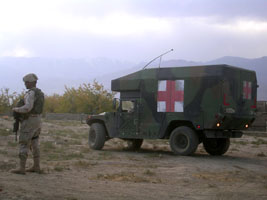 |
CC employee Innis Bryant (left) and his battalion treated several thousand Afghanis while overseas.
|
When Sergeant First Class Innis Bryant and his taskforce battalion of soldiers with the National Guard’s 29th Infantry Division rolled into the Afghanistan village on one of their visits, the local villagers were already lined up, waiting anxiously for the Americans they had been told would arrive. Men, women and children stretched on in multiple queues that spanned the lengths of football fields—all waiting for medical services.
Bryant returned to the United States in August 2005 after 18 months of training and service as a medical officer in Afghanistan. And even though several months have passed since he has resumed his work at the Clinical Center as a staff respiratory therapist, he can still recount the stories of how he felt and the faces of the people he treated overseas with the detail and emotion of someone who just stepped off the plane.
Bryant’s taskforce battalion of 800 soldiers were in Afghanistan from July 2004 to July 2005 with the mission to provide peace and stability to the area of operation, while his 30-person platoons were responsible for providing medical care to the sick and wounded. The original mission was to provide medical support for U.S. soldiers, but after time on the ground it became obvious there was another need. “Our mission typically is to conserve the fighters’ strength,” Bryant explains. “We are there to provide support for U.S. soldiers, but when 90 percent of the people you are treating are Afghanis, the mission changes.”
Bryant estimates that his battalion treated several thousand Afghanis, sometimes seeing 400 in a single day. “We provided care to anyone who needed it, including enemy combatants,” Bryant says. “Every villager received the same level of health care as the U.S. soldiers did. My guys stayed busy helping people.”
Early in the morning, the soldiers would load up ambulances and other vehicles and start the often
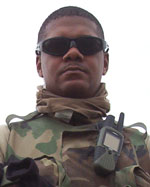 |
“Every villager received the same level of health care as the U.S. soldiers did. My guys stayed busy helping people.”
—Innis Bryant, CC staff respiratory therapist
|
hours-long journeys into remote villages to serve as traveling clinics. Referred to as “tailgate medicine” by the troops, these traveling clinics provided general medical care, including basic inoculations and trauma care when needed. The U.S. forces would coordinate their arrival with local elders and police, establishing a coordinated relationship between the Americans and the Afghan community.
“For many villagers, this was their first time seeing a school-trained physician,” Bryant says. “Seeing their faces when we helped them—it was about being a part of something great.”
In addition to his aid bag, Bryant was never without his M-4 assault rifle and 9 mm handgun—just part of the job. When a protest in the city of Ghazni turned violent and the local police chief was shot, the chief insisted he be brought to the Americans instead of the local hospital. “We saved his life,” says Bryant. “Later he came back and thanked us.”
Bryant and his team were also on hand to support the security forces for the first Afghani elections—a day that Bryant remembers with awe as more than 80 percent of voters showed up at various locations. “We were expecting the worst, but it was a good day.”
His duty in Afghanistan was not the first overseas military service for Bryant. He was in active duty for 11 years before he began working at the CC and joined the National Guard. “This was the first deployment where I left a job behind.” In addition to leaving his job at the CC, Bryant also left behind his three sons Innis Jr., 12, Darien, 11, and Xavier, 8—who he kept up with via satellite phone, instant messaging and e-mail.
After more than a year away from his home, family and job, Bryant turned in his weapons in July and boarded the plane that would take him to Kuwait, then Kyrzykstan and later on to Fort Bragg, N.C.
“People ask me, ‘When did you feel like you were safe or that it was over?’ I tell them, ‘Not until I was in Kuwait,’” Bryant says. He begins to tell the story of a good friend who was in a different battalion. After 11 months in Afghanistan, and with only one more month of service remaining, her helicopter went down in a windstorm, killing her and 15 other soldiers on board. As only someone on the frontlines of battle can explain, it isn’t over until you’re home—and even then, “over” isn’t quite the right word.
—By Kathryn Boswell
Back to Top
CC Nurse Manager Kate Musallam retires after 24 years
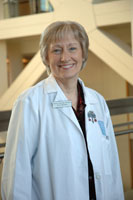 |
“They have been my family,” says retiree Kate Musallam of her CC colleagues and friends.
|
Thanks to the influence of her childhood doctor and family friend, CC Nurse Manager Kate Musallam’s affinity for the medical profession began when she was young. Dr. Norris is the person she credits for inspiring her to pursue a career in medicine.
“Dr. Norris was a gentle, caring man who, even after my family moved to Texas from my hometown of Seattle, continued to write me notes on envelopes and prescription pad paper. I still have them,” says Musallam. “My family took a trip back to Seattle when I was a teenager and I visited Dr. Norris, who had retired. I told him my career plans and what a great influence he had been on my life.”
Equipped with a diploma in nursing from St. Joseph School of Nursing in Fort Worth, Texas; and a bachelor’s and master’s degree from Catholic University in Washington, D.C., Musallam has spent most of her 38 years of nursing in supervisory roles.
In 1979, she was driving to a job interview and got lost on her way there. The wrong turn took her on to the NIH campus. “It was huge,” Musallam says. “I didn’t know what in the world this place was.”
That wrong turn later turned out to be a right one, because in 1982 Musallam returned to the NIH campus—this time not as an accident, but for a job.
She started work at NIH as an oncology staff nurse and then transferred to the aging research unit—an NIA intramural program studying Alzheimer’s disease—where she was selected as nurse manager in 1984. “It was a very exciting time,” she recalls. “Because we were meeting many of these patients in the early stages of the disease and following them over the years, we were beginning to characterize what the disease looked like over time.”
Her work with the adult Alzheimer’s patients is one of the memories that Musallam says she cherishes the most. “I would often take the patients on walks around the campus. When they would return to NIH after many months away, and often with their memory further impaired, they always remembered the walks. Some of them could even remember the exact path and would lead me to their favorite spots like the rose garden.”
Because the program had a small staff and only six inpatient beds, Musallam’s group often shared space with other units. “It was a challenge to keep our dementia patients safe because we couldn’t lock the doors,” she explains. Musallam and the other nurses discussed the challenge at a staff meeting and together they came up with a creative solution. With the help of NIH engineers, Musallam’s staff developed a watch-like piece of equipment that would automatically lock the hallway doors if a patient wearing the device came within five feet of the space. After publishing their findings in the International Journal of Technology and Aging, the ingenious technology became the new standard for elder care.
In 1998, Musallam moved to the role of nurse manager for NIMH’s OP 4 and 4W. In 2001, she transferred to manage OP 4, 7 and 10. She also managed the Vaccine Research Center for two years and oncology for a few months. She was a member of the NIH Disaster Medical Assistance Team (DMAT) from 1986 to 1993 and a member of the NIH Speaker’s Bureau for several years.
Musallam, whose retirement begins March 31, looks forward to working part-time and volunteering in the community as well as skiing, gardening, hiking and golfing at the family’s mountain home in Virginia.
—By Louise Canada
Back to Top
CC says farewell to CRIS pioneer Dr. Rosenfeld
Dr. Stephen Rosenfeld, CC chief information officer since 2004 and leader of the Clinical Research Information System (CRIS)
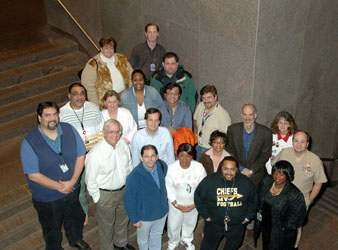 |
Surrounded by a group of coworkers, Dr. Stephen Rosenfeld (in second row, second from right) is honored for his contributions to the Clinical Center’s medical information systems.
|
development team, took on a new challenge in February. He was named chief information officer for MaineHealth in Portland. The non-profit health system comprises hospitals—including the 606-bed tertiary care and teaching hospital, Maine Medical Center—and physician practices, long-term care facilities and home-care agencies.
“It’s an opportunity to structure a medical information system that pulls together a patient’s total health-care record,” he says, “so it can transfer from hospitals to outpatient clinics to individual doctors’ offices.”
Moving possibilities into practice has marked Rosenfeld’s career at the Clinical Center. He led the team that in 2004 designed, built and implemented CRIS. Transitioning from MIS, the CC’s pioneering electronic system that was in use for nearly 30 years, to CRIS was a multi-year, complex undertaking with a schedule tied inextricably to the opening of the new hospital.
“Putting in CRIS was something the CC had to do,” he says. “We put together the team, and everybody in the organization rose to the project’s demands.”
The team recently introduced a major upgrade for the system, one that provides new options for organizing and viewing data and expanded capability for clinical documentation. Groundwork is in place for CRIS’s next phase, a data warehouse that will improve the availability of clinical information for research.
When Rosenfeld came to NIH in 1989—as a clinical associate and later a fellow with NHLBI—computers were simply a hobby. “I didn’t take any computer classes as an undergraduate—it would have meant getting up at 6 a.m. and walking across campus to the mainframe.”
After graduating from Yale, he earned an MD at Cornell and completed residency training at Dartmouth. In 1993 he joined the CC staff as a senior staff physician in what was the Clinical Pathology Department. “I became the IT guy, he says, “and found it much more fun than the bench work I had been doing.”
A joint appointment with the CC’s former Information Systems Department gave Rosenfeld an opportunity to continue as an attending in hematology while helping design and build a data repository for MIS. Along the way he earned an MBA from Georgetown University. In 2001, he became chief of the Department of Clinical Research Informatics, and in that capacity, headed the CRIS project.
“I’ve grown up in the NIH environment,” he says, “and being here has given me the rare opportunity to find and pursue the work that I love. My time at the Clinical Center has taught me the value of pursuing dreams rather than expectations.”
As the search for Rosenfeld’s successor continues, Lisa A. Lacasse, the CC’s chief financial officer, has assumed the role of acting associate director for clinical research information systems. Lacasse has been involved in the CRIS project, initially as a member of the project management team and currently as a member of the CRIS steering committee.
Dr. Jon McKeeby, who has served as Rosenfeld’s deputy chief information officer, has been appointed the acting CIO. McKeeby has worked in the CC for 14 years on multiple system implementations, including CRIS, and has had operational responsibility for much of the Clinical Research Informatics Department.
Back to Top
News briefs
Atrium safety measures
Safety netting installed around the atrium of the NIH Clinical Center will be in place until a
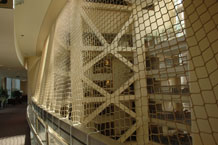 |
|
Safety netting in the Clinical Center.
|
permanent architectural modification is designed and installed. Representatives from the CC, NIMH and the NIH Office of Research Facilities are collaborating with architectural experts to determine the best approach for permanent modifications that will enhance safety. Proposals are expected in late March.
CC in the news
Washington Times, Feb. 7, 2006—Holly Parker, recreational therapist in the CC Rehabilitation Medicine Department, was quoted in the article, “Animals Assist Healing,” about the volunteer therapy dogs that visit CC patients. “We have seen patients. . . have significant responses to dogs,” Parker said. “It’s those little sort of steps forward that make this such an important part of our program.”
Physician’s Weekly, Feb. 6, 2006, and Radiology Today, Jan. 30, 2006—The article titled, “New CAD Technology Detects Polyps, Increases Comfort,” featured Dr. Ronald M. Summers, chief of the CC imaging processing group, and his work on computer-aided detection (CAD) software combined with virtual colonoscopy for the detection of colon polyps. Summers, the lead study author, demonstrated that CAD will likely benefit clinical practice. “The results suggest that [CAD] does perform very well at finding polyps. Also, we were able to clarify the polyp size ranges for when it works most efficaciously.”
Take Your Child to Work Day 2006
This year NIH celebrates its 12th annual Take Your Child to Work Day. On Thursday, April 27, from 9 a.m. to 4 p.m., the NIH institutes and centers will host educational and fun activities designed to let our children (ages 8–15) experience the world of biomedical research and public service. Information on activities and registration requirements are online, http://takeyourchildtowork.nih.gov/. With your help, we can promise a day of fun, learning and career ideas for you and your children, organizers say. If you would like to sponsor an activity on Take Your Child to Work Day 2006 or for general information and to volunteer, please contact Gary M. Morin, committee chair, (301) 496-4628 voice, (301) 480-3122 TTY; moring@od.nih.gov.
Pager recall alert
Some 102 pagers that were recalled by the manufacturer last fall may still be in use by NIH staff with clinical responsibilities. If you have one of the recalled pagers, you risk missing important messages. The recalled pager has a white/silver inset faceplate and the letters TTI at the lower right corner. On back are the model name, TTI Prestige 870, and RIC 1 codes 0004000 and above. If you have this pager, please contact the CIT pager group as soon as possible for a no-cost replacement. Email: rusherd@mail.nih.gov or call 301-496-1833.
Celebrating Nursing Science:
The Research-Practice Link
As part of the yearlong celebration marking the 20th anniversary of the National Institute of Nursing Research, NINR and the CC’s Department of Nursing and Patient Care Services have announced a conference to celebrate achievements in clinical nursing research and their application to practice. The conference will be Friday, June 16, from 8 a.m. to 3:30 p.m. in the Masur Auditorium. Visit http://ninr.nih.gov/ninr and click on “Save the Date: June 16” to review conference highlights and register online. If you are going to submit an abstract you must register. For more information, contact Dr. Donna Jo McCloskey at (301) 496-1446 or mccloskd@mail.nih.gov.
New research facilities website allows online maintenance requests and more
The NIH Office of Research Facilities (ORF) has launched a new website with enhanced information on NIH facilities as well as improved navigation for finding the information you are looking for. The site is at http://orf.od.nih.gov. The site allows visitors to do all of the following and much more: submit a maintenance request, check on a scheduled utility shutdown, locate a facility manager by building, find information on submitting a request for space and view the NIH Strategic Facilities Plan. Comments and suggestions are welcome at orfresponse@mail.nih.gov.
Public Health Grand Rounds: Learning from Katrina
Join the National Library of Medicine for the next broadcast of Public Health Grand Rounds, “Learning from Katrina: Tough Lessons in Preparedness and Emergency Response,” to be presented on March 31, 2006, from 2 to 3 p.m. Discussions include tough lessons learned and share the experiences of public health leaders and community partners in surviving and responding to a disaster named Katrina. To register, go to http://publichealthgrandrounds.unc.edu. This program may be viewed at a satellite downlink site or as a webcast. Registration, program information and a list of currently available sites are available online. If you do not find a site near you on the program’s website, contact grandrounds@unc.edu or (919) 843-9261.
Volunteers needed for clinical studies
Children’s asthma study
This study will evaluate the usefulness of a new procedure for evaluating asthma in children ages five to 17. All study-related tests will be provided at no cost. Compensation provided. Call (866) 444-2214, TTY (866) 411-1010. Refer to study 04-I-0126.
African/African-Americans blood count study
Healthy African-Americans or Africans are needed for a blood count study. You can help us understand why individuals have different white blood cell counts. Call (866) 444-2214, TTY (866) 411-1010. Refer to study 03-DK-0168. Compensation provided.
NIH is currently enrolling families in which an adult or child has one of the following: Rheumatoid arthritis/juvenile rheumatoid arthritis, systemic lupus erythematosus, systemic sclerosis or myositis within four years of diagnosis. The study consists of a blood draw, urine collection and survey completion. Participants must have a sibling of the same gender within four years of age and be from the same parents. Compensation provided. Call (866) 444-2214, TTY (866) 411-1010. Refer to study 03-E-0099.
Ovarian function study
Healthy women ages 18 through 25 are needed for ovarian function study. Compensation provided. Call (866) 444-2214, TTY (866) 411-1010. Refer to study 00-CH-0189.
Healthy volunteers needed
NIH doctors are conducting a study that examines the tongue. Call (866) 444-2214, TTY (866) 411-1010. Refer to study 01-CC-0044. Compensation provided.
Do you have enlarged gums and are taking dilantin, cyclosporine or calcium channel-blockers? If so, call (866) 444-2214, TTY (866) 411-1010 to participate in this study. Refer to study 05-D-0103.
Myositis study
Patients with myositis are needed to participate in a research study. Study related tests are at no cost to the patient and study treatment may be available. Call (866) 444-2214, TTY (866) 411-1010. Refer to study 91-AR-0196.
Do you have Diabetes Type 1 or Type 2 and kidney disease? If so, call (866) 444-2214, TTY (866) 411-1010 to participate in study 05-DK-0113.
HIV+ volunteers off anti-HIV-medications, CD4+ 350 or greater and without Hepatitis B or C are needed for a research study at NIH. Compensation provided. Call (866) 444-2214, TTY (866) 411-1010. Refer to study 05-I-0065
Malaria vaccine study
NIH doctors are conducting a study to test the safety of a research malaria vaccine and its ability to generate immunity. Healthy males or non-pregnant females, between the ages of 18 and 50, who have never been exposed to malaria may consider participating. All study-related tests and medicines are provided at no cost, and compensation will be provided. The research vaccine will not infect you with malaria. Call (866) 444-2214, TTY (866) 411-1010. Refer to study 05-I-0133.
NIDDK thyroid cancer study
Individuals recently diagnosed with thyroid cancer, call (866) 444-2214, TTY (866) 411-1010 for details on a thyroid cancer study.
Healthy volunteers needed
NICHD is seeking healthy volunteers, ages 18-30, to participate in an investigational anthrax vaccine. Medical tests will determine eligibility. All study related tests are provided at no cost. Compensation provided. Call (866) 444-2214, TTY (866) 411-1010. Se habla español. Refer to study 04-CH-0283.
Follicular lymphoma study
Your own body may be your best defense. Patients who have not had chemotherapy call for Lymphoma Vaccine Study. Call (866) 444-2214, TTY (866) 411-1010.
Parkinson’s disease study
Take part in a Parkinson’s disease study. Call (866) 444-2214, TTY (866) 411-1010.
Muscular leg pain
If you have muscular leg pain that occurs with activity but improves with rest, it may be caused by blocked arteries. Call (866) 444-2214, TTY (866) 411-1010 for more information on a new study.
Gray Platelet Syndrome (GPS) is a rare bleeding disorder that causes excessive bleeding and bruising. NIH doctors invite those with GPS and their families to participate in a study to identify the gene(s) that cause the disorder. Families with at least one member diagnosed with GPS may be eligible to participate in this study. Participants will be required to obtain and ship a blood sample to NIH for genetic analysis. No travel is required for this study and you will be reimbursed for any shipment costs. To participate, contact Dr. Meral Gunay-Aygun at (301) 594-4181 or (866) 444-2214, TTY (866) 411-1010 or mgaygun@nih.gov.
Back to Top
News celebrities come to NIH to share expertise
From left to right: TV news co-anchor Doreen Gentzler (WRC NBC4) and news correspondents Lisa Stark (ABC News) and Susan Dentzer (PBS) served as panelists at last month’s NIH Communication Forum. Each shared advice with NIH communicators about how to recognize a potential television story as well as personal insight about the current health-reporting environment.
John Burklow, NIH associate director for communications and public liaison, introduced the speakers, saying, “NIH wants to expand its reach and knowledge into the world of television. How can we best collaborate with you to get our research results out to the world?”
Back to Top
Upcoming Events
March 8 (Wednesday)
Noon–1 p.m. Lipsett Amphitheater
Grand Rounds: Zoonoses: Where the Wild Things Are
Arnold N. Weinberg, MD, Professor of Medicine, Harvard Medical School
March 8 (Wednesday)
3 p.m. Masur Auditorium
NIH Director’s Lecture
Regulation of the Production of IL-10 by T-Cells, Macrophages and Dendritic Cells: Implications for Immune Responses to Pathogens
Anne O’Garra, PhD, Head, Laboratory of Immunoregulation, National Institute for Medical Research, London
March 15 (Wednesday)
Noon–1 p.m. Lipsett Amphitheater
Grand Rounds: Targeting Insulin Sensitivity in the Management of Cardiovascular Disease
Michael N. Sack, MD, PhD, Tenure-Track Investigator, Cardiovascular Branch, NHLBI
Genetic Insights into Atherosclerosis and Heart Disease
Paul M. Hwang, MD, PhD, Tenure-Track Investigator, Cardiovascular Branch, NHLBI
March 15 (Wednesday)
3 p.m. Masur Auditorium
NIH Director’s Lecture
Genome-Scale Maps, Measures and Models of Mitochondrial Function
Vamsi Mootha, MD, Assistant Professor of Systems Biology, Harvard Medical School
March 22 (Wednesday)
Noon–1 p.m. Lipsett Amphitheater
Grand Rounds: HIV Vaccine Development: A Global Imperative
Barney S. Graham, MD, PhD, Chief, Viral Pathogenesis Laboratory,
Chief, Clinical Trials Core, NIAID
Genetic Origins of Congenital Cataracts
J. Fielding Hejtmancik, MD, PhD, Medical Officer, Chief, Molecular Ophthalmic Genetics Section, NEI
March 22 (Wednesday)
3 p.m. Masur Auditorium
NIH Director’s Lecture
Genetic Modeling Tumors of the Nervous System in Mice
Luis F. Parada, PhD, Professor of Cell Biology and Director, Center for Development Biology, UT Southwestern Medical Center
March 27 (Monday)
12:30 p.m. Masur Auditorium
Manchester String Quartet Concert
March 29 (Wednesday)
Noon–1 p.m. Lipsett Amphitheater
Grand Rounds: Regulation of Allergic Reactions by G-Protein-Coupled Signal Transduction
Kirk Druey, MD, Senior Investigator, Laboratory of Allergic Diseases, NIAID
Cyclic Nucleotide Phosphodiesterases: Therapeutic Targets Above and Below the Diaphragm
Vincent Manganiello, MD, PhD, Chief, Section on Biochemical
Physiology, NHLBI
To view other NIH and Clinical Center events, click here.
Back to Top
|
|
Clinical Center News, National
Institutes of Health, Building 10, 10 Center Drive, Room 12C440, Bethesda, MD 20892-1504. Tel: 301-496-6787.
Fax: 301-402-2984. Published monthly for CC employees
by the Office of Communications, Patient Recruitment, and Public Liaison. News, article ideas,
calendar events, letters, and photographs are welcome.
Back to Top
|
|


 The information on this page is archived and provided for reference purposes only.
The information on this page is archived and provided for reference purposes only.